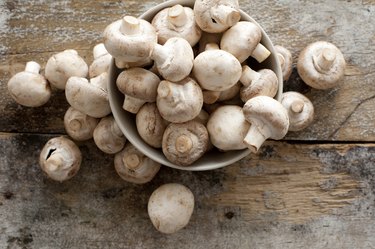
Mushrooms are full of health benefits, and they add a unique flavor to any meal. With so many different varieties available, from shiitake mushrooms to oyster mushrooms, it's definitely worth keeping a package or two of these fungi around. Sometimes, though, you might leave them in the fridge for slightly longer than intended, only to rediscover them a short while later. If you're wondering whether your mushrooms are still safe to eat, there are a few foolproof ways to figure it out.
How Long Do Mushrooms Last in the Fridge?
Video of the Day
Mushrooms have a high water content, so they spoil rather quickly if not properly stored. Many varieties are sold in shrink-wrapped plastic at the grocery store, but this isn't the best method of at-home storage. Plastic and air-tight containers speed up the spoiling process. Instead, transfer your mushrooms to a paper bag. Opt to buy whole mushrooms rather than sliced, and do not wash the mushrooms until you're ready to use them.
Video of the Day
Properly stored whole mushrooms typically last for four to seven days in the fridge. Sliced mushrooms, on the other hand, generally last for one or two days.
You can preserve your mushrooms for much longer by freezing them. First, sauté the mushrooms until they're mostly cooked, and then pack them tightly into an air-tight container. They'll last in the freezer for about a year.
How Can You Tell if Mushrooms Are Bad?
Mushrooms are often a little dirty already, and they come in so many different shapes and sizes. It can be tricky to tell whether they look how they're supposed to look. However, you can use a few different methods to pinpoint any signs of spoilage.
Check the Expiration Date
First thing is first: Is there an expiration date on the container of mushrooms? If so, it's a good idea to chuck the mushrooms once that date has passed, particularly if you're unsure of whether they seem spoiled or not.
Examine the Surface
If the mushrooms appear quite dry or wrinkly, they're likely too old to eat. Also, if the color has changed in any way since you first bought them, that's a telltale sign of spoilage. Examples include darkened gills, discolored spots or spots of mold.
One easy method is to flip the mushrooms over and look at the gills. Spoiled mushrooms often have darkened, shriveled or wet gills.
Use Your Nose
Spoiled mushrooms may emit a foul, ammonia-like odor. Fresh mushrooms should mostly smell like dirt and fungi. If you get a whiff of something foul when you open the container, the mushrooms are spoiled.
Feel the Texture
Lastly, spoiled mushrooms are frequently covered in a coating of slime. Fresh mushrooms should be dry and firm; they may be a bit damp, but they are never slimy. On the opposite end of the spectrum, some mushrooms dry out when they're spoiled rather than become slimy. In either case, it's best to throw them away.
What Does a Bad Mushroom Look Like?
There are hundreds of different mushroom varieties out there, so there is no defining visual characteristic of a bad mushroom. An enoki mushroom that has gone bad may look quite different than a bad baby bella mushroom. However, bad mushrooms often exhibit a few of the same signs. They may be covered in slime, have discolored spots, have darkened gills or look dry and wrinkly.
Can You Cook With Spoiled Mushrooms?
Never cook with spoiled mushrooms. It's not worth the risk. Contaminated food can cause serious illness, with symptoms including vomiting, diarrhea and abdominal pain. If you notice that your mushrooms are starting to lose their freshness, cook them immediately and freeze them before they spoil.